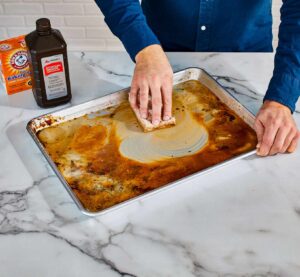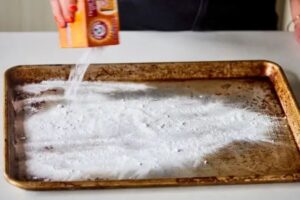A dirty pan vs. a seasoned pan
It’s important to distinguish between grime and seasoning. Grease, burnt-on bits of food, and basically any kind of debris left on your baking sheet after cooking count as grime that should be washed off. Seasoning is the same thing as seasoning on a cast-iron pan: layers of hard, polymerized oil baked onto the pan over time.
Seasoning accumulates when you bake things long and hot or when you put your pan in the oven with a little residual oil on it from last time you used it (this is why the sides, corners, and underside of your sheet pan may get darker than the surface, since those are the areas that get neglected in washing).
A well-seasoned baking sheet is great for a few reasons. Seasoning helps aluminum—a very sticky metal—be less sticky, in the same way it helps cast iron pans release eggs or cornbread. It also helps protect from corrosion that’s caused by acidic foods like tomatoes. And finally, the darker surface (even if it’s just the underside of the pan) absorbs heat better than reflective bare aluminum, leading to more browning (here’s a great video by cooking instructor Helen Rennie showing the difference). That extra browning is great for roasting things like vegetables or meat.
Yes, there are some times when you might want less browning––when baking delicate cookies, for example. For those times, I suggest you keep a couple dedicated baking sheets clean (and always use parchment paper when baking cookies). But if you have a bunch of seasoned pans, you could also scrub a couple back to their original finish.
What you need
- Dish soap: Whatever you usually use will do, as long as it’s good at cutting through grease. We like the pleasantly unscented Seventh Generation Free & Clear Dish Soap.
- A sponge with a scouring side: Using a good, sturdy scouring pad like the green side of a Scotch-Brite Heavy Duty Scrub Sponge will make cutting through stuck-on messes easier. The soft side of the sponge is great for wiping off any stubborn grease.
- A dish brush (optional): A good nylon scrubber like the OXO Good Grips Dish Brush will quickly loosen crusty foods after you’ve given your pan a good soak.
- Bar Keepers Friend or baking soda (optional): Should you decide to try to remove some of the seasoning that’s accumulated on your pan, these are two of the most effective and accessible cleaning agents you can use. Bar Keepers Friend did marginally better when we tried them side by side.
How long will this take to clean?
If nothing is too stuck to your pan, it should just take a few minutes to wash thoroughly by hand. For tougher, stuck-on food and grease, add an extra 30 minutes to let your pan soak.
If you decide to tackle the baked-on coating of oil on a well-used pan, you’ll need to let the pan sit with a coating of baking soda or Barkeepers Friend and water for 30 minutes to an hour. After that, you’ll have to spend at least 15 to 20 minutes scrubbing, and you still might not get everything off. Again, you really don’t need to do this.

How to clean baking sheets
Everything below applies mainly to bare aluminum baking sheets, which are what we recommend. It should also hold true for steel or aluminized steel baking sheets, which are less common. Don’t use these techniques to clean a nonstick baking sheet—you’ll destroy the nonstick coating.
Everyday cleanup (even for tough messes)
If your baking sheet is just a little greasy or nothing is too stuck to it, wash it thoroughly by hand with hot water and dish soap. If you’re hoping to minimize the buildup of seasoning, be careful to get all the grease out of the corners of the pan, and don’t forget to wash the underside of the pan thoroughly.
For tougher, stuck-on messes, fill the pan with hot water, drizzle in a little dish soap, and let it sit for about 30 minutes. Then tackle those crusty spots with a dish brush or the scouring side of a sponge. After a good soak, most gunk should lift off pretty easily with just a quick scrubbing. Finish with a rinse, a final once-over with a soapy sponge, and one more rinse in hot water.
It’s most effective to hand-wash your baking sheets. Plus, a trip through the dishwasher will tarnish the bare aluminum, though it won’t ruin your pans. Nordic Ware, the maker of our favorite baking sheet, says the tarnish “is merely cosmetic and will not affect baking properties or safety of the pan.”

Getting back to bare metal (if you really want to)
You really don’t have to remove the seasoning on your old baking sheet. It’s not unsanitary, it can make your pan perform better, and a baking sheet with a nice patina is a total look. But if you want to, here’s how:
First, make a paste of warm water and either Bar Keepers Friend or baking soda. (I tried both, and Bar Keepers Friend was ever so slightly better at getting down to the bare aluminum.) You can make the paste in a small dish then rub it over the pan, or you can coat the pan in a thick layer of cleaner, then sprinkle a little water over it and mix with your fingers (use gloves). Either way, add water slowly.
Let the coated pan sit for at least 30 minutes. When time is up, grab your scouring pad and scrub hard. It’ll take a while. You may even need to give it a few tries.
Once you’ve removed as much as you can, wash the baking sheet thoroughly with soap and water. And to prevent future buildup, be extra careful to wash every bit of oil off your pan every time you use it.
This article was edited by Amy Koplin and Sofia Sokolove.
